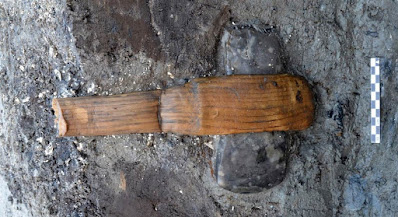Only eight complete Stone Age axes with the full wooden handle preserved have been found in Denmark before now. All of those were discovered in peat bogs. This is the first example discovered on the site of a former fjord lagoon. Jammed into the dense clay of the seabed, the axe was covered in layers of sand and soil that kept oxygen away and waterlogged the organic material, keeping it moist and intact.
Museum Lolland-Falster archaeologists discovered the axe stuck vertically 30 centimeters (just under a foot) below the sea floor east of the harbour town of Rødbyhavn. It was not the only artifact found jammed into what was then the seashore in a vertical position. There were numerous wooden candlesticks, two oars, two bows, eight spears and 14 axe shafts. There were also deposits of ceramic objects and animals. In one grouping they found 60 jaws from different animals and two axes made from red deer antlers with fragments of the wooden hilts in the shaft holes. This was the only complete axe with both head and hilt in perfect condition.
Axes were important tools for Stone Age people, but particularly so around the time when agriculture was introduced to the region. In order to begin planting things, people had to clear the virgin forests that covered the country. The establishment of stationary agricultural communities engendered new social hierarchies and religious rituals. Wetlands were a consistent locus for cultic practices, and burials and sacrificial offerings testify to how important these liminal grounds between water and land were to the people who lived near them.
Axes were important tools for Stone Age people, but particularly so around the time when agriculture was introduced to the region. In order to begin planting things, people had to clear the virgin forests that covered the country. The establishment of stationary agricultural communities engendered new social hierarchies and religious rituals. Wetlands were a consistent locus for cultic practices, and burials and sacrificial offerings testify to how important these liminal grounds between water and land were to the people who lived near them.




0 comments:
Post a Comment